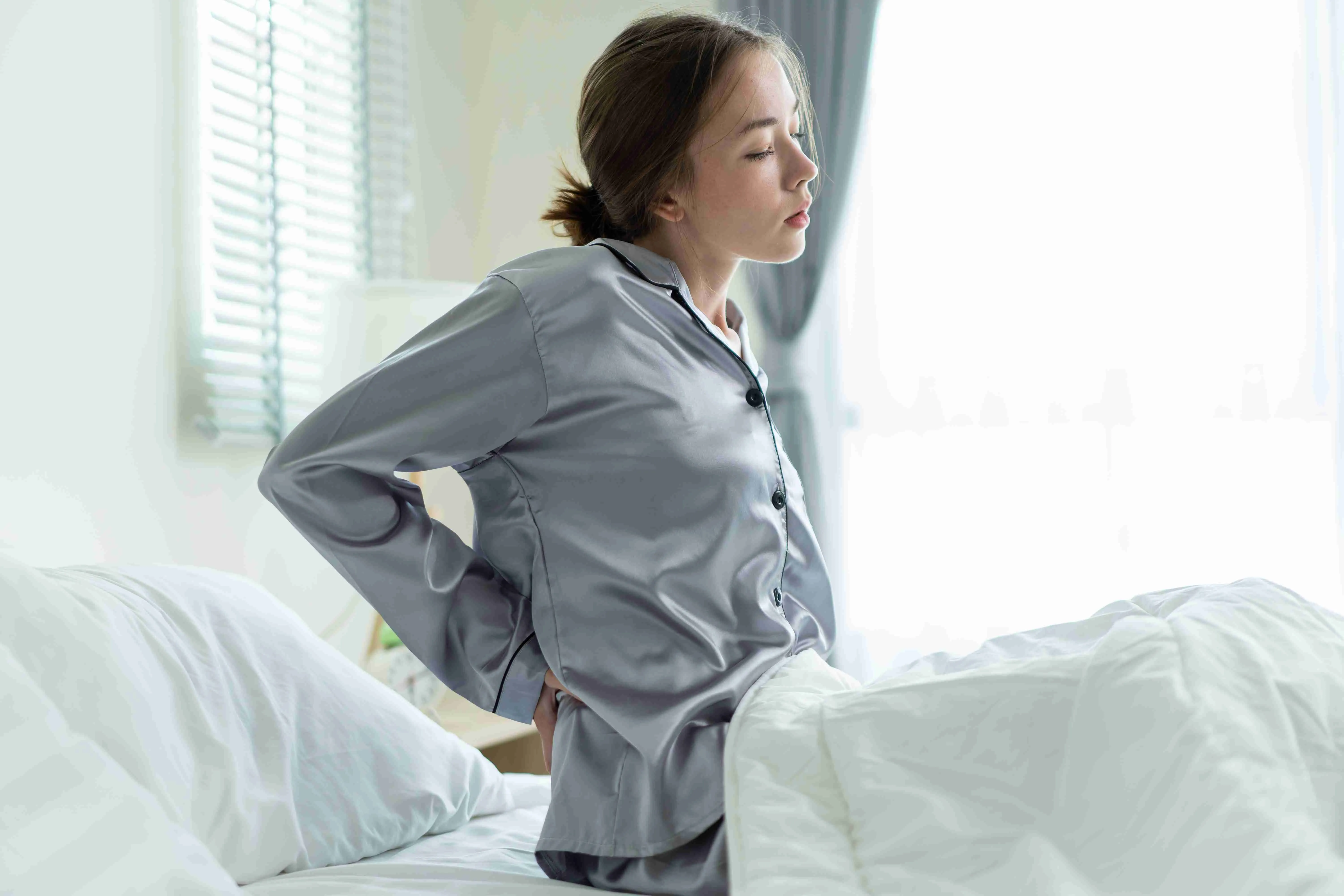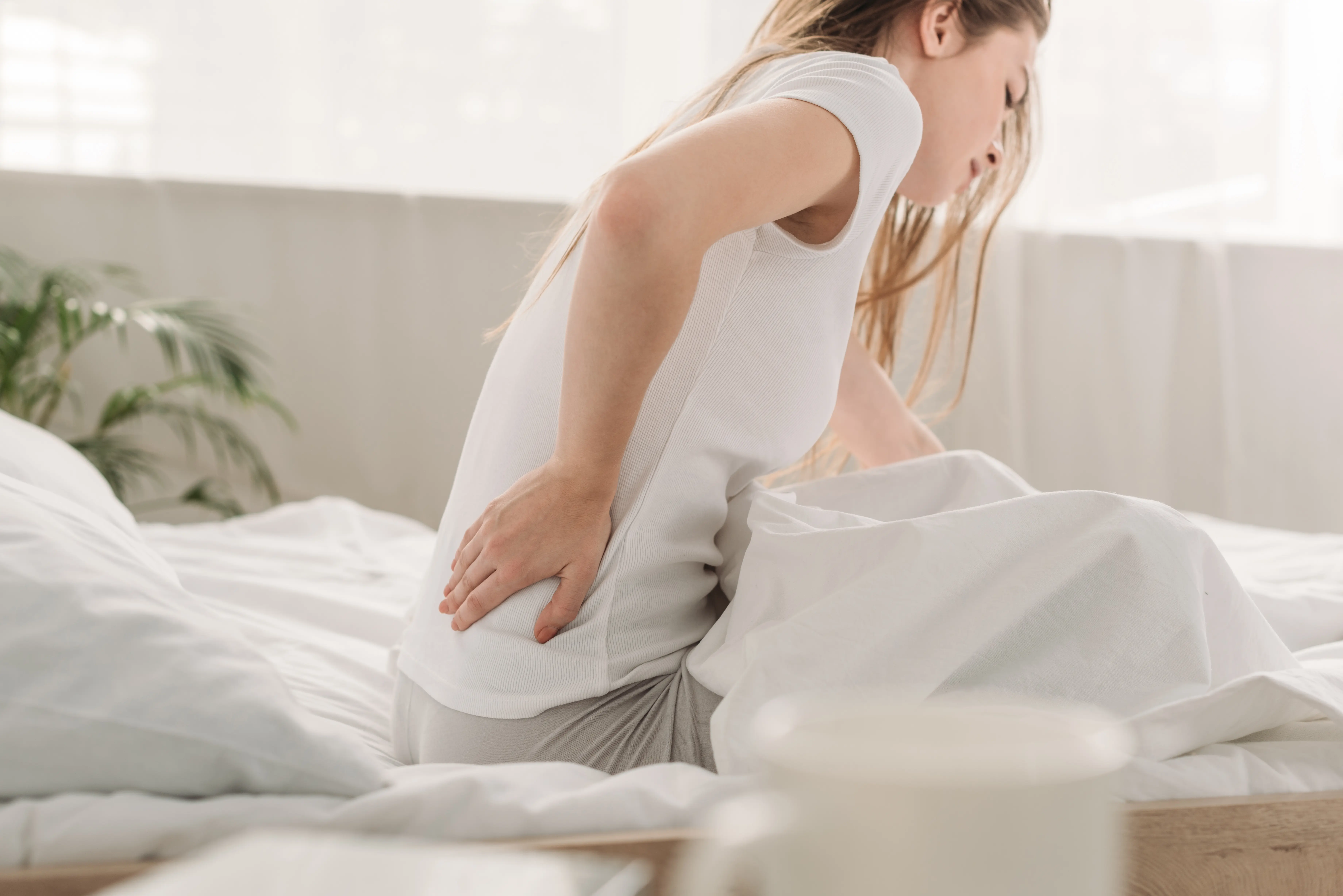Sleep is a vital component of overall physical health and mental well-being, playing a crucial role in physical recovery, cognitive function, and emotional stability.
However, for individuals suffering from lower back pain, achieving quality sleep can often feel elusive. The importance of sleep cannot be overstated, as it not only aids in the healing process but also helps to manage pain levels and improve overall mood.
In this article, we will delve deeper into the types and causes of back pain, as well as how to adapt sleep practices to accommodate lower back pain.
The Connection Between Sleep and Back Pain

The connection between sleep and back pain is a critical area of concern for many individuals. Quality sleep is essential for overall health, and inadequate rest can exacerbate existing back pain or even contribute to its development.
Poor sleep posture, combined with insufficient support from mattresses or pillows, can lead to misalignment of the spine, resulting in discomfort and chronic conditions. Conversely, experiencing back pain can hinder one's ability to achieve restful sleep, creating a vicious cycle that affects daily functioning.
Therefore, addressing both sleep quality and back pain is crucial for improving overall well-being and enhancing quality of life. Check out the Best Mattresses for Back Pain.
How Pain Disrupts the Sleep Cycle
Pain can significantly disrupt the sleep cycle, leading to a cascade of negative effects on overall health and well-being. When individuals experience pain, it often results in difficulty falling asleep and maintaining restorative sleep throughout the night.
This disruption can lead to chronic sleep deprivation, exacerbating the perception of pain and creating a vicious cycle.
Additionally, the physiological stress response triggered by pain can further impair sleep quality, inhibiting the body's ability to enter deep sleep stages essential for healing and recovery.
Understanding how pain disrupts the sleep cycle is crucial for developing effective pain management strategies and improving sleep hygiene.
Types of Back Pain
Back pain is a prevalent condition that can manifest in various forms, primarily categorized into lower, middle, and upper back pain, as well as neck pain.
Each type of back pain has distinct characteristics, causes, and treatment options, making it essential for individuals to understand their specific symptoms and underlying issues.
Lower Back Pain
Lower back pain is one of the most common complaints among adults, and it will be the main focus of this article. This condition can stem from a variety of factors, including muscle strain, herniated discs, or degenerative conditions such as arthritis.
This type of pain may be acute or chronic, often presenting as a dull ache or sharp discomfort that can radiate down the legs. It can significantly hinder daily activities and quality of life.
Early intervention through physical therapy, medication, or lifestyle modifications can often lead to effective management and relief of lower back pain.
Middle Back Pain
Middle back pain, while less common than its lower counterpart, can still pose significant challenges. This area of the back, also known as the thoracic region, is less mobile than the lumbar region and is often affected by poor posture or repetitive strain injuries.
Individuals who spend long hours sitting at desks or engaging in activities that require forward bending may experience discomfort in this area.
Treatment typically involves posture correction, stretching exercises, and ergonomic adjustments to work environments to alleviate strain on the middle back.
Upper Back and Neck Pain
Upper back and neck pain are frequently interrelated conditions that can arise from similar sources, such as tension, stress, or prolonged periods of poor posture.
Upper back pain may manifest as a tightness between the shoulder blades or aching in the neck region. Neck pain specifically may result from injuries like whiplash or conditions such as cervical spondylosis.
Addressing upper back and neck pain often requires a holistic approach that includes physical therapy, massage, and stress management techniques.
Lower Back Pain Causes

Understanding the causes of lower back pain is crucial for implementing preventive measures and seeking appropriate treatment to alleviate it effectively.
Muscle Strain or Injury
This type of pain often results from overexertion, poor lifting techniques, or sudden movements that put excessive pressure on the muscles and ligaments supporting the spine.
Individuals who engage in physically demanding activities or maintain poor posture for extended periods are particularly susceptible to such strains.
Herniated or Bulging Discs
This condition occurs when the soft material inside a spinal disc pushes through a crack in the tougher exterior casing, potentially pressing on nearby nerves.
The pain can vary in intensity and may radiate to other areas, such as the legs. Factors contributing to herniated or bulging discs include age-related degeneration, obesity, and repetitive heavy lifting.
Degenerative Disc Disease
Degenerative disc disease occurs when the intervertebral discs in the spine lose hydration and elasticity over time, leading to reduced cushioning between the vertebrae.
This degeneration can result in chronic pain, decreased mobility, and, in some cases, nerve compression. As the discs deteriorate, the likelihood of experiencing lower back pain increases, impacting daily activities and overall quality of life.
Sciatica
Sciatica is another significant cause of lower back pain, characterized by pain that radiates along the sciatic nerve, which runs from the lower back down through the legs.
This condition often results from herniated discs or spinal manipulation that compresses the nerve roots. Individuals suffering from sciatica may experience sharp pain, numbness, or weakness in one leg, making it challenging to perform routine tasks.
Check out our list for the Best Mattresses for Sciatica.
Poor Posture and Prolonged Sitting
Poor posture, characterized by slouched shoulders and misaligned spines, places undue stress on the lumbar region, leading to discomfort and pain.
Additionally, a sedentary lifestyle, especially in ergonomically unsound environments, can exacerbate muscle tension and weaken core stability. Together, these factors create a cycle of strain that impacts overall spinal health.
Best Sleeping Positions for Lower Back Pain
Finding the best sleeping positions for lower back pain is crucial for ensuring a restful night and promoting overall spinal health.
Sleeping on Your Back
Sleeping on your back can also be beneficial for lower back pain if done correctly. Placing a small pillow under the knees can help maintain the natural curve of the spine and relieve pressure on the lumbar area.
This position encourages an even distribution of weight along the spine, potentially reducing discomfort.
Side Sleeping
One of the most recommended positions is sleeping on your side, as this can help reduce pressure on the lower back.
When adopting a side sleeping position, it is beneficial to place a pillow between your knees. This alignment helps keep the spine in a neutral position and reduces strain on the lumbar region.
Fetal Position
Another effective sleeping position is the fetal sleeping position. Curling up slightly while lying on your side allows for a natural curvature of the spine, which can be particularly soothing for individuals suffering from lower back discomfort.
Like side sleeping, this position also benefits from using a pillow between the knees to maintain proper alignment and minimize tension in the back muscles.
Mattress and Pillow Considerations for Back Pain

When it comes to managing back pain, one of the most crucial yet often overlooked factors is the choice of mattress and pillow. The right mattress can significantly impact sleep quality, spinal alignment, and overall comfort, which are vital for individuals suffering from back pain.
Choosing the Right Mattress
When selecting a mattress for back pain, several key considerations come into play to ensure optimal support and comfort.
One of the primary factors is the type of mattress material. Some of the best mattress materials for lower back pain are:
- Memory Foam Mattresses: Memory foam mattresses are a popular choice for back pain sufferers due to their ability to contour to the body’s shape, alleviating pressure points while providing support. Check out our list of the best memory foam mattresses.
- Hybrid Mattresses: Hybrid mattresses combine innerspring coils with foam layers, providing both support and comfort. It is crucial to consider personal preferences regarding temperature regulation, as some materials may retain heat more than others, potentially disrupting sleep quality. Check out our list of the best hybrid mattresses.
- Latex Mattresses: Latex mattresses are known for their durability and ability to provide excellent support while conforming to the body’s natural curves. They distribute weight evenly, which can alleviate pressure points that often contribute to back pain. This quality makes latex an appealing choice for individuals seeking relief from discomfort during sleep. Check out our list of the best latex mattresses.
- Innerspring Mattresses: Innerspring mattresses have been a long-standing option for many sleepers. They typically feature coils that provide a bouncy feel and varying levels of firmness. While these mattresses can offer adequate support, they may not always contour to the body as effectively as latex or memory foam alternatives. Therefore, individuals with back pain should consider the coil count and gauge when evaluating innerspring mattresses to ensure they deliver the necessary support. Check out our list of the best innerspring mattresses.
- Adjustable Beds: Adjustable beds present another innovative option for those experiencing back pain. These beds allow users to customize their sleeping position, which can help reduce strain on the back and enhance overall comfort. By elevating certain areas of the body, adjustable beds can promote better spinal alignment and alleviate pressure on sensitive areas, making them a worthwhile consideration for individuals seeking relief from chronic back pain. Check out our list of the best adjustable beds.
Proper Pillow Support
Selecting an appropriate pillow is equally vital for individuals experiencing back pain. The pillow should provide adequate support for the neck and head while maintaining proper spinal alignment.
For back sleepers, a medium-loft pillow that keeps the head level with the spine is ideal. Side sleepers may benefit from a thicker pillow that fills the space between the shoulder and head, while stomach sleepers generally require a thinner pillow to prevent neck strain.
The material of the pillow can also affect comfort; options such as memory foam, latex, or down can cater to different sleeping styles and preferences.
Tips for Sleeping with Lower Back Pain
Sleeping with severe lower back pain can be a challenging experience, but there are several strategies to enhance comfort and ensure a restful night.
Pre-Bedtime Stretches and Exercises
One effective strategy is incorporating pre-bedtime stretches and exercises into your nightly routine. Engaging in gentle stretches, such as the child’s pose or cat-cow stretch, can help alleviate tension in the lower back and promote relaxation.
These targeted movements not only improve flexibility but also enhance blood flow to the affected area, potentially reducing discomfort.
Heat and Cold Therapy
One effective approach to mitigate the risk factors of lumbar pain and lower back pain involves incorporating heat and cold massage therapy into your routine. Applying a heating pad or warm compress can help relax tense muscles and alleviate stiffness, while a cold pack may reduce inflammation and numb sharp pain. Alternating between these therapies before bedtime can create an optimal state for sleep.
Sleep Environment Optimization
Optimizing your sleep environment is crucial for managing lower back pain. Start by selecting a supportive mattress that provides the right balance of firmness and cushioning for your body type.
Consider the use of pillows strategically placed to support the natural curvature of your spine. Furthermore, maintaining a cool, dark, and quiet bedroom can significantly improve sleep quality.
Managing Stress
Managing stress is crucial; high stress levels can exacerbate pain, making it difficult to fall asleep. Techniques such as meditation, deep breathing, or progressive muscle relaxation can help reduce stress and promote a more restful night's sleep.
Lifestyle Changes
To mitigate the impact of back pain on your sleep, it is crucial to implement certain lifestyle changes that can enhance your nightly rest and promote better spinal health. By adopting these strategies, individuals suffering from lower back pain can improve their sleep environment and habits, leading to a more comfortable and restful night.
- Physical Activity: Regular physical activity is paramount; engaging in low-impact exercises such as stretches for lower back pain, walking, swimming, or yoga can enhance core strength and improve flexibility, ultimately supporting spinal health.
- Maintaining a Healthy Weight: Maintaining a healthy weight is crucial since excess body weight can put additional strain on the lower back. A balanced diet rich in anti-inflammatory foods can also contribute to managing pain levels and promoting overall well-being.
- Establishing a Consistent Bedtime Routine: This includes going to bed and waking up at the same time each day, which helps regulate the body’s internal clock and enhances sleep quality.
- Seek Professional Guidance When Necessary: If lower back pain persists despite implementing these lifestyle changes, consulting with a healthcare provider or physical therapist can yield personalized recommendations tailored to your specific condition. They may suggest targeted exercises or treatments that can further alleviate pain and improve your overall quality of life.
FAQs
What firmness level is best for lower back pain?
Generally, a medium-firm mattress is recommended as it provides a balance of support and comfort. This firmness level helps maintain proper spinal alignment while alleviating pressure points, which can be beneficial for lower back pain relief.
How often should I replace my mattress if I have back pain?
It is recommended to replace your mattress every 7 to 10 years, but if you are experiencing persistent back pain, you may need to evaluate it sooner. An old or worn-out mattress can lack the necessary support and alignment needed for your spine, exacerbating discomfort.
How long does it take for sleep adjustments to improve pain?
People may start to notice changes within a few weeks of implementing better sleep hygiene practices. However, full benefits may take several months of consistent effort. Factors such as the severity of pain, underlying health conditions, and individual responsiveness to sleep adjustments play critical roles in this timeline.
Are there specific pillows designed for back pain relief?
Yes, there are specific pillows designed for back pain relief. These pillows often feature ergonomic designs that support the natural curvature of the spine, promoting proper alignment during sleep. Memory foam and contour pillows are popular choices, as they provide individualized support and pressure relief.
How to treat lower back pain?
Initial treatment often includes rest, applying ice or heat, and over-the-counter pain relievers. Physical therapy can be beneficial, focusing on strengthening exercises that improve flexibility and core stability.
Does fibromyalgia contribute to lower back pain?
Individuals with fibromyalgia may experience lower back pain more frequently than those without the condition. The heightened sensitivity to pain associated with fibromyalgia can exacerbate discomfort in the lower back, leading to increased pain perception and muscle tension.
Conclusion
Managing lower back pain while trying to achieve quality sleep requires an understanding of various strategies that promote comfort and spinal health. The importance of sleep cannot be ignored; it is vital for healing and overall well-being.
By investing in suitable mattresses and pillows, establishing calming bedtime rituals, and adopting supportive sleeping positions, individuals can enhance their chances of achieving restorative sleep despite their discomfort.
Ultimately, prioritizing these factors not only contributes to better sleep but also aids in long-term management of lower back pain, fostering a healthier lifestyle overall.
Dom Abraham
As the lead content writer at Sleepiverse. Dom pours his heart into writing mattress reviews, bedding product reviews, and medically-reviewed health articles. Dom is from Portugal and likes to spend his free time writing on the beach as it gives him a sense of comfort. Aside from writing mattress reviews in front of the soothing beach view, Dom likes to experiment with new amazing food ideas.


